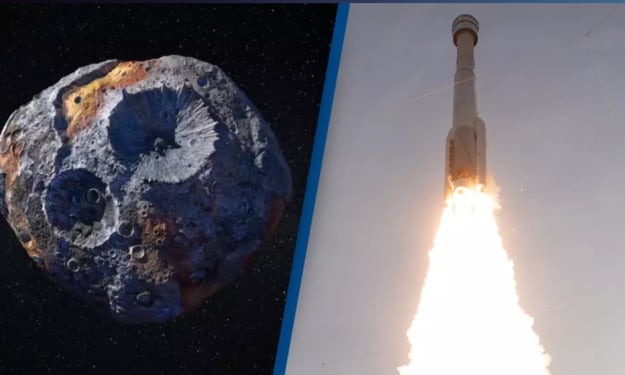Content warning
This story may contain sensitive material or discuss topics that some readers may find distressing. Reader discretion is advised. The views and opinions expressed in this story are those of the author and do not necessarily reflect the official policy or position of Vocal.
Massive Asteroid Passing Earth
A Closer Look at this Celestial Spectacle

Introduction to the massive asteroid passing earth
In recent news, astronomers and space enthusiasts around the world are abuzz with excitement as a massive asteroid is set to pass close to Earth. This celestial spectacle has captured the imagination of people from all walks of life, sparking curiosity about the science behind such events. In this article, we will delve into the fascinating world of asteroids and explore what causes them to come close to our planet.
What causes asteroids to come close to Earth?
Asteroids are rocky objects that orbit the Sun, much like planets. They are remnants from the early days of our solar system and are primarily found in the asteroid belt, a region located between the orbits of Mars and Jupiter. However, occasionally, some asteroids deviate from their usual path and come perilously close to Earth.
One of the main reasons for asteroids coming close to our planet is gravitational interactions. The gravitational pull of nearby planets, especially Jupiter, can influence the trajectory of asteroids and cause them to change their orbit. This phenomenon, known as a gravitational slingshot, can propel asteroids towards Earth or alter their path in such a way that they cross our planet's orbit.
Another factor that contributes to asteroids coming close to Earth is known as a resonance. When the orbital period of an asteroid is in sync with that of Earth, they align at certain points in their respective orbits. This alignment can lead to close encounters, as the gravitational forces between Earth and the asteroid cause their paths to intersect.
The significance of this celestial spectacle
The passage of a massive asteroid near Earth holds great significance for scientists and researchers. It provides a unique opportunity to study these celestial bodies up close and gather valuable data that can enhance our understanding of the universe. By analyzing the composition, size, and shape of the asteroid, scientists can gain insights into the formation and evolution of our solar system.
Furthermore, studying the trajectory of asteroids can help scientists refine their models and predictions for future encounters. This information is vital for developing strategies to mitigate the potential risks associated with asteroids that may pose a threat to Earth in the future.
The science behind the orbit of the massive asteroid
Understanding the science behind the orbit of the massive asteroid passing Earth requires delving into the principles of celestial mechanics. The orbit of an asteroid is determined by its velocity, the gravitational pull of the Sun and other celestial bodies, and the initial conditions at the time of its formation.
Asteroids can have elliptical, circular, or even highly eccentric orbits. The shape and characteristics of an asteroid's orbit are influenced by numerous factors, including its distance from the Sun, the gravitational influence of nearby planets, and the presence of other asteroids in its vicinity.
To accurately predict the orbit of a massive asteroid, scientists employ a combination of observational data, computer simulations, and mathematical calculations. By inputting known variables, such as the asteroid's mass, velocity, and the gravitational forces acting upon it, scientists can model its trajectory and predict its future path.
Tracking and predicting the trajectory of asteroids
Tracking and predicting the trajectory of asteroids is a critical aspect of asteroid research. To accomplish this, scientists utilize a variety of techniques and technologies, including ground-based telescopes, space-based observatories, and radar systems.
Ground-based telescopes play a crucial role in detecting and monitoring asteroids. By observing the movement of these celestial bodies over time, astronomers can calculate their orbits and predict future close encounters. Space-based observatories, such as the Hubble Space Telescope, provide a unique vantage point from which to observe asteroids and gather detailed information about their composition and physical characteristics.
Radar systems are another essential tool in tracking asteroids. By bouncing radio waves off the surface of an asteroid and measuring the time it takes for the waves to return, scientists can precisely determine the distance, size, and shape of the object. This information is invaluable in refining the predictions of an asteroid's trajectory and assessing potential risks.
How close will the asteroid come to Earth?
The proximity of the massive asteroid passing Earth is a subject of great interest and concern. Scientists have been meticulously observing and calculating its trajectory to determine the closest approach. Based on current data, it is estimated that the asteroid will come within a few hundred thousand kilometers of our planet.
While this may seem like a considerable distance in astronomical terms, it is relatively close when considering the vastness of space. The close encounter presents an excellent opportunity for astronomers to study the asteroid in detail and gather valuable information about its composition and physical properties.
Potential effects of a close encounter with an asteroid
Although the massive asteroid passing Earth poses no immediate threat to our planet, it is essential to understand the potential effects of a close encounter with an asteroid. Depending on the size and composition of the object, a collision with Earth could have catastrophic consequences.
Small asteroids, typically less than a few hundred meters in diameter, would likely burn up in the Earth's atmosphere before reaching the surface. However, larger asteroids could cause significant damage upon impact. The release of energy from the collision could lead to widespread destruction, including the formation of craters, tsunamis, and even global climate change.
Therefore, studying and tracking asteroids is of paramount importance in order to identify those that pose a potential threat and develop strategies to mitigate the risks associated with their close approaches.
Safety measures and precautions taken during such events
When a massive asteroid passes close to Earth, safety measures and precautions are put in place to ensure the well-being of the population. International organizations, such as NASA and the International Asteroid Warning Network, collaborate to monitor and assess the potential risks associated with near-Earth asteroids.
Early detection is crucial in providing sufficient time to evaluate the threat and plan appropriate responses. Advanced telescopes and radar systems are employed to detect and track asteroids, enabling scientists to make accurate predictions about their trajectory and potential impact.
In the event of a significant threat, various contingency plans are put into action. These plans include potential methods to deflect or destroy the asteroid, evacuation procedures for areas at risk, and coordination between international agencies to ensure a unified response.
Historical instances of close asteroid encounters
Throughout history, there have been several notable instances of close asteroid encounters that have captured public attention and fueled scientific inquiry. One such example is the Tunguska event, which occurred in 1908 in Siberia, Russia. An asteroid or comet exploded in the atmosphere, releasing an immense amount of energy and flattening trees over an area of 2,000 square kilometers.
More recently, in 2013, a meteor exploded over Chelyabinsk, Russia, injuring over 1,000 people and causing widespread damage. This event served as a reminder of the potential risks associated with asteroids and highlighted the importance of continued research and monitoring.
Conclusion and future prospects in asteroid research
In conclusion, the passage of a massive asteroid close to Earth is a captivating celestial spectacle that provides valuable insights into the science behind these cosmic objects. By studying their orbits, composition, and potential impacts, scientists can enhance our understanding of the universe and develop strategies to mitigate the risks associated with close encounters.
The close approach of the massive asteroid passing Earth serves as a reminder of the need for continued research and monitoring of near-Earth asteroids. Through the use of advanced technologies and international cooperation, scientists can improve their ability to detect, track, and predict the trajectories of these celestial bodies, ensuring the safety and well-being of our planet.
As we look to the future, the field of asteroid research holds great promise. Advancements in technology and increased collaboration between scientific organizations will undoubtedly lead to further discoveries and a deeper understanding of these cosmic wonders. By unraveling the mysteries of asteroids, we unlock the secrets of our solar system and gain valuable insights into the origins and evolution of our universe.






Comments
There are no comments for this story
Be the first to respond and start the conversation.